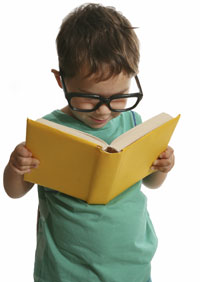Around this time of year, some parents start playing the comparison game. They notice that when it comes to reading, other children are skipping through sentences or even delving into chapter books. Yet their own child stumbles through sounding out words or struggles to complete a page. Jim Trelease, author of The Read-Aloud Handbook, says you can’t hurry lit. “Just as not all children are born with a full of head of hair, not all kids are ready to read at the same age,” he says. Trelease offers the following analogy: Suppose you’d like your infant to have a full head of hair for his 6-month baby photos, but he’s bald as a cue ball. “You can’t put any hair on the kid,” Trelease says, no matter what you do. There’s no miracle salve, and you can’t enroll him in a remedial hair-growth program to build follicular skills.
other children are skipping through sentences or even delving into chapter books. Yet their own child stumbles through sounding out words or struggles to complete a page. Jim Trelease, author of The Read-Aloud Handbook, says you can’t hurry lit. “Just as not all children are born with a full of head of hair, not all kids are ready to read at the same age,” he says. Trelease offers the following analogy: Suppose you’d like your infant to have a full head of hair for his 6-month baby photos, but he’s bald as a cue ball. “You can’t put any hair on the kid,” Trelease says, no matter what you do. There’s no miracle salve, and you can’t enroll him in a remedial hair-growth program to build follicular skills.
Some countries accommodate developmental differences. In Finland, children begin formal lessons at age 7, after their American counterparts. But by age 9, their reading scores surpass American scores. Trelease points out a critical difference: Finnish TV features many close-captioned shows. Those words are a big motivator for Finnish kids who want to get in on grown-up jokes. “Reading is equal parts will and skill,” says Nancy Place, an associate education professor at the University of Washington, Bothell. “Will is composed of the emotional commitment and connection,” she observes. If kids feel positively about reading, “they’re much more likely to do some of the hard work.”
And as Place points out, proficiency is a process, not an end product. As adults, we still learn how to “read” new texts, whether poetry or instant messages. Place calls this “multiple literacies.” Children move through the process at varying rates and ages. Some kids progress quickly, while others take their time. And some of us still struggle over deciphering Chaucer.
But here’s how you can help your child — without pressure:
Prime the pump
“You couldn’t get too far without gas in the car,” Trelease says. “Oral vocabulary is the gas in our car.” An abundant word tank allows readers to draw meaning when encountering new words later on, so take time to discuss everyday life with your child and explain unfamiliar terms. Provide a variety of experiences (plays, parks or a pro sports game) to build little lexicons. Trelease gives this example: A child may be able to sound out words, but if you give her an article on an Australian cricket match, she’ll wonder what in the world those people are talking about. Without context, words are strings of letters sans meaning.
Select texts
“One of the key factors in motivation is choice,” says Place. So if your child brings home a book beyond his reading level, try letting him read a word every few pages, or a short sentence here and there. At the bookstore, if she wants a video game guide, don’t push Pollyanna. Read the write way. Encourage writing as an expressive path to reading. Write notes to one another and place them in envelopes at your imaginary post office. Or help your child write real letters to Grandpa, and she’ll begin to pick up those sound-letter connections — but don’t worry too much about “correct” spelling.
Play games
Take the drudgery out of decoding by playing the label game: Write easy-to-read names of items on Post-Its, then ask your child to help “label” your home, from “RUG” to ”DAD.” Play charades with simple words or spell funny words with letter magnets on your fridge. As children get older, break out the Mad Libs and crossword puzzles. Or play mini-spelling bee as a traffic distraction, as Seattle mom Polly Grow does by asking her sons to spell rhyming words.
For more ideas, see Games for Reading by Peggy Kaye.
Lora Shinn is a Seattle mother, writer and children’s librarian.









